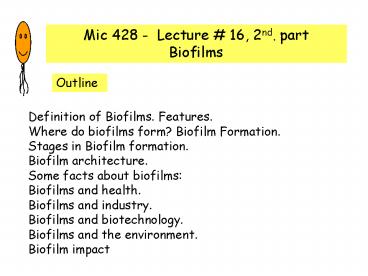Mic 428 Lecture - PowerPoint PPT Presentation
1 / 8
Title:
Mic 428 Lecture
Description:
Biofilms may form: 1. on solid substratums in contact with moisture, ... Biofilms may form on almost any surface including plant roots, within humans and ... – PowerPoint PPT presentation
Number of Views:120
Avg rating:3.0/5.0
Title: Mic 428 Lecture
1
Mic 428 - Lecture 16, 2nd. part Biofilms
Outline
Definition of Biofilms. Features. Where do
biofilms form? Biofilm Formation. Stages in
Biofilm formation. Biofilm architecture. Some
facts about biofilms Biofilms and
health. Biofilms and industry. Biofilms and
biotechnology. Biofilms and the
environment. Biofilm impact
2
What are biofilms?
Biofilms are microbial communities attached to an
environmental surface. These microorganisms
usually encase themselves in an extracellular
polysaccharide or slime matrix.
3
Biofilms may form1. on solid substratums in
contact with moisture,2. on soft tissue
surfaces in living organisms, and 3. at
liquid-air interfaces.
4
How do biofilms form?
5
Stages in Biofilm Formation
6
Where are biofilms found?
Almost everywhere!
Biofilms may be found on any environmental
surface where sufficient moisture and nutrients
are present. Their development is most rapid in
flowing systems where adequate nutrients are
available.
Biofilms may form on almost any surface including
plant roots, within humans and animals, and
moist, inorganic surfaces. Biofilms on contact
lenses and indwelling medical devices are some of
the most medically significant types of biofilms.
7
Why is destroying biofilms so important?
Health
Industries
Otitis media, cystic fibrosis, Leggionaire
disease, endocarditis
Pipe plugging, corrosion, water contamination
Adapted from www.erc.montana.edu
8
Mechanisms of Biofilm Resistance to Antimicrobial
Agents
Biofilms evade antimicrobial challenges by
multiple mechanisms. These we have grouped into
three broad categories
1. Reduction of the antimicrobial concentration
in the bulk fluid surrounding the biofilm.
2. Failure of the antimicrobial agent to
penetrate de biofilm
3. Adoption of a resistant physiological state or
phenotype by at least a fraction of the cells in
a biofilm
http//www.erc.montana.edu/CBEssentials-SW/researc
h/Antimicrobials/































